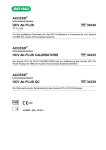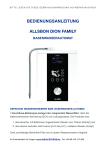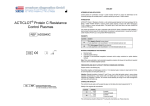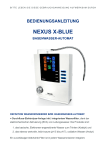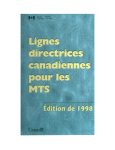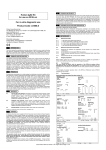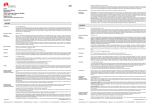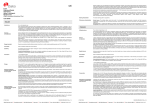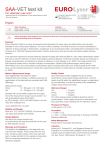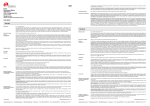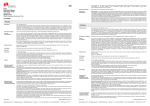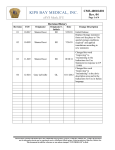Download ce-ivd spec template
Transcript
Cystatin C Immunoparticles Code No./ Réf./ Code-Nr. LX002 ENGLISH Intended use For in vitro diagnostic use. For professional use only. Cystatin C Immunoparticles are intended for the quantitative determination of cystatin C in human serum, heparinized plasma and EDTA plasma by turbidimetry and nephelometry. Cystatin C measurements are used as an aid in the diagnosis and treatment of renal diseases. Summary and explanation Cystatin C is a small, 13 kDa, non-glycosylated basic protein belonging to the cystatin super-family of cysteine protease inhibitors. Cystatin C is produced by virtually all nucleated cells, and is present in all investigated body fluids. The production rate is constant and is unaffected by inflammatory processes, gender, age and muscle mass (1). In the normal kidney, cystatin C is almost freely filtered through the glomerular membrane and then nearly completely reabsorbed and degraded by the proximal tubular cells. Therefore, the plasma concentration of cystatin C is almost exclusively determined by the glomerular filtration rate (GFR), making cystatin C an excellent indicator of GFR. Numerous studies and a meta-analysis incorporating 4492 subject samples have shown that serum cystatin C is superior to serum creatinine as a marker for GFR (2). Test principle Human serum or plasma is mixed with the Cystatin C Immunoparticles. The resulting immune complexes are measured by turbidimetry or nephelometry. The signal generated is correlated with the concentration of cystatin C in the sample. By interpolation on a standard curve, the concentration of cystatin C in the sample is calculated. Reagent Purified immunoglobulin fraction of rabbit antiserum directed against cystatin C covalently coupled to uniform polystyrene particles. Provided as a suspension and preserved with 15 mmol/L sodium azide. The Cystatin C Immunoparticle suspension is ready for use. Immunogen Recombinant human cystatin C produced in E. coli was used as immunogen for raising the antibody coupled to the polystyrene particles. Precautions 1. For in vitro diagnostic use. For professional users. 2. Interpretation of results must be made within the context of the patient’s clinical history and other diagnostic tests by a certified professional. 3. The possibility of antigen excess, i.e. antigen concentrations exceeding the security range of the assay, should be considered. 4. This product contains sodium azide (NaN3) a chemical highly toxic in pure form. At product concentrations, though not classified as hazardous, sodium azide may react with lead and copper plumbing to form highly explosive build-ups of metal azide. Upon disposal, flush with large volumes of water to prevent metal azide build-up in plumbing. 5. As with any product derived from biological sources, proper handling procedures should be used. Storage Store at 2-8 C. Do not use after expiration date stamped on vial. If reagents are stored under any conditions other than those specified, the user must verify the conditions. If unexpected results are obtained which cannot be explained by variations in laboratory procedures and a problem with the reagent is suspected, contact our Technical Services. For on-board stability data please refer to the Specific Performance Characteristics for the specific instrument. Specimens Sample material: Human serum, heparinized plasma and EDTA plasma. Samples can be stored at 2-8 C, if analysed within 2 days. Otherwise, samples must be stored at -20 C. Samples are stable for at least 6 months at -20 C. It is recommended that frozen samples are thawed at 37 C; samples must be mixed well before analysis. As with any product derived from biological sources, proper handling procedures should be used. For interference please refer to the Specific Performance Characteristics for the specific instrument. Procedure Materials provided Dako Cystatin C Immunoparticles Code No. LX002 Materials required but not provided Dako Cystatin C Calibrator Dako Cystatin C Control Set Dako Reaction Buffer 9 Diluent Code No. X0974 Code No. X0973 Code No. S2361 See the Application Note for the individual instrument Assay procedure Detailed, validated Application Notes for the determination of cystatin C in human sample material, based on optimized test systems (3), are available from Dako for a range of automated instruments. Applications Notes for Hitachi 917 and IMMAGE® Immunochemistry System are included on the following pages. For instruments not covered by a specific Application Note, a General Application Note, which provides general assay procedure guidelines is available. When using the General Application Note, each individual laboratory should validate their test system. Please consult the instruction manual of the instrument used regarding precautions, operation, maintenance, and instrument performance characteristics. Establishment of the calibration curve The assigned value of the Dako Cystatin C Calibrator, code No. X0974, is given on the Analytical Value Sheet included with the calibrator. The exact measuring range depends on the specific lot of the calibrator and the Application Note for the individual instrument. (105527-004) LX002/EFG/CS/12.09.05 p. 1/16 Dako Denmark A/S · Produktionsvej 42 · DK-2600 Glostrup · Denmark · Tel. +45 44 85 95 00 · Fax +45 44 85 95 95 · CVR No. 33 21 13 17 Calibration curves are constructed by multi-point calibration. Depending on the instrument, a dilution series is either prepared automatically by the instrument or manually, and then applied on the instrument. For details on interval for recalibration, please refer to the following pages. Assay of samples Samples are measured according to the Application Note for the individual instrument. If the results obtained are outside the measuring range, the assay can be repeated using a post concentration or post dilution of the sample as stated in the Application Note. Internal quality control Dako Cystatin C Control 1 and Control 2, code No. X0973, must be assayed with each establishment of a calibration curve and with each run of samples. The controls should be assayed and evaluated as samples. The assigned values and confidence intervals are given on the Analytical Value Sheet included with the controls. If quality control results fall outside the range stated on the Analytical Value Sheet or outside the range established by the individual laboratory, recalibration is recommended. Results The analytical results are automatically calculated by the instrument. Limitations For interference please refer to the Specific Performance Characteristics for the specific instrument. Expected values Individuals 1-50 years: Individuals >50 years: 0.55-1.15 mg/L 0.63-1.44 mg/L The reference intervals were determined from a population of 69 subjects 50 years and 94 subjects > 50 years of age, all with normal glomerular filtration rate. The reference intervals were calculated using non-parametrical statistics and represent the central 95% of the population. Healthy individuals 50 years of age have generally a glomerular filtration rate above 80 mL/min/1.73 m 2, whereas the glomerular filtration rate of healthy individuals > 50 years decreases with age (4). The above reference intervals may be used as a guide for demonstrating normal or reduced GFR, but it is recommended to determine the reference intervals for the local population. Specific performance The Dako Cystatin C Assay is based on the usage of Dako Cystatin C Immunoparticles characteristics together with Dako Cystatin C Calibrator, Dako Cystatin C Control Set, Dako Reaction Buffer 9, and the diluent recommended in the Application Note for the specific instrument. Please refer to the following pages for the Specific Performance Characteristics for the Dako Cystatin C Assay on Hitachi 917 and IMMAGE Immunochemistry System. Specificity The specificity of the cystatin C antibody, before coupling to the particles, was ascertained by crossed immunoelectrophoresis. Only the cystatin C arch appeared when the antibody was tested against concentrated human urine from patients with tubular proteinuria. Method comparison assay. Results obtained with the Dako Cystatin C assay were compared with a commercially available nephelometric Estimation of GFR Measurement of the serum/plasma cystatin C concentration allows for estimation of GFR (5). Plasma cystatin C from cystatin C concentration has been measured with the Dako Cystatin C assay on 536 patients, who underwent iohexol clearance determination (4). The patients covered an age range from four months old to 93 years old. The following equation for estimation of GFR has been established (5): GFR (mL/min/1.73 m2) = [84.69 x cystatin C (mg/L)-1.680] * The equation results in the following relationship between cystatin C and GFR: GFR (mL/min/1.73 m2)* 0.6 200 0.7 154 0.8 123 0.9 101 1.0 85 1.1 72 1.2 62 1.3 55 1.4 48 1.5 – 1.6 41 1.7 – 1.8 33 1.9 – 2.0 28 2.1 – 2.3 23 2.4 – 2.6 18 2.7 – 3.0 15 3.1 – 4.0 10 250 GFR (mL/min/1.73 m2) Cystatin C (mg/L) 200 150 100 50 0 0.5 1 1.5 2 2.5 3 3.5 4 4.5 5 5.5 Cystatin C (mg/L) * If the patient is < 14 years of age, the result has to be multiplied with a prepubertal factor of 1.384. The equation and table above provide estimates of GFR adjusted to a standard body surface area of 1.73 m 2 (mL/min/1.73 m2). To obtain estimates of absolute GFR (mL/min), multiply the result obtained in the equation or table above with the patient’s estimated body surface area (9) divided by 1.73. The equation and table may be used as guidelines for estimating GFR, but it is recommended that each individual laboratory verify the equation. FRANÇAIS Utilisation prévue (105527-004) Réservé au diagnostic in vitro. Pour utilisateurs professionnels uniquement. LX002/EFG/CS/12.09.05 p. 2/16 Dako Denmark A/S · Produktionsvej 42 · DK-2600 Glostrup · Denmark · Tel. +45 44 85 95 00 · Fax +45 44 85 95 95 · CVR No. 33 21 13 17 Les tests Cystatin C Immunoparticles sont conçus pour la détermination quantitative de la Cystatine C, par turbidimétrie ou néphélométrie, dans le sérum humain, le plasma hépariné et le plasma EDTA. Les mesures de la Cystatine C contribuent au diagnostic et au traitement des pathologies rénales. Résumé et explication La Cystatine C est une petite protéine, non-glycosylée d’un poids moléculaire de 13 kDa, appartenant à la super famille cystatine des inhibiteurs des cystéines-protéinases. La Cystatine C est produite par pratiquement toutes les cellules nucléées, et est présente dans tous les fluides corporels examinés. Son taux de production est constant et n’est pas affecté par les processus inflammatoires, le sexe, l’âge et la masse musculaire (1). Dans le rein sain, la Cystatine C est filtrée presque librement à travers la membrane glomérulaire et est ensuite presque complètement réabsorbée et dégradée par les cellules tubulaires proximales. Par conséquent, la concentration plasmatique en Cystatine C est presque exclusivement déterminée par le taux de filtration glomérulaire (TFG), faisant de la Cystatine C un excellent indicateur du TFG. De nombreuses études et des méta-analyses incorporant 4492 échantillons ont montré que la Cystatine C sérique est supérieure à la créatinine sérique en tant que marqueur pour le TFG (2). Principe du test Le sérum ou le plasma humain est mélangé avec des Cystatin C Immunoparticles. Les complexes immuns qui en résultent sont mesurés par turbidimétrie ou néphélométrie. Le signal généré est mis en corrélation avec la concentration en Cystatine C de l’échantillon. La concentration en Cystatine C dans l’échantillon est calculée par interpolation sur une courbe d’étalonnage. Réactif Fraction d'immunoglobuline purifiée d'antisérum de lapin dirigé contre la Cystatine C et couplée par covalence à des particules de polystyrène uniformes. Fournie en suspension et conservée avec de l’azide de sodium à15 mmol/L. La suspension de Cystatin C Immunoparticle est prête à l’emploi. Immunogène La Cystatine C humaine recombinante exprimée dans E. coli a été utilisée comme immunogène pour mettre en évidence l'anticorps couplé aux particules de polystyrène. Précautions 1. Réservé au diagnostic in vitro. Pour utilisateurs professionnels. 2. Les résultats doivent être interprétés par un professionnel qualifié et tenir compte des antécédents cliniques du patient et d’autres tests diagnostiques. 3. La possibilité d´un excès d’antigènes, c’est-à-dire de concentrations en antigène excédant la plage de sécurité du test, doit être prise en compte. 4. Ce produit contient de l’azide de sodium (NaN3), un produit chimique très toxique sous sa forme pure. Aux concentrations du produit, bien que non classé comme dangereux, l’azide de sodium peut réagir avec le cuivre et le plomb des canalisations pour former des accumulations d’azides métalliques hautement explosifs. Lors de l’élimination, rincer abondamment à l’eau pour éviter toute accumulation d’azide métallique dans les canalisations. 5. Comme avec tout produit d’origine biologique, des procédures de manipulation appropriées doivent être respectées. Conservation Conserver entre 2 et 8 °C. Ne pas utiliser après la date limite de péremption indiquée sur le flacon. Si les réactifs sont conservés dans des conditions autres que celles qui sont indiquées, celles-ci doivent être validées par l’utilisateur. En cas de résultats inattendus ne pouvant être expliqués par un changement des procédures du laboratoire et en cas de suspicion d’un problème avec le réactif, contacter nos services techniques. Pour des données concernant la stabilité dans l´appareil, veuillez vous rapporter aux Caractéristiques de performance spécifiques pour l’appareil spécifique. Échantillons Échantillons : Sérum humain, plasma hépariné ou plasma EDTA. Les échantillons peuvent être conservés entre 2 et 8 °C, s’ils sont analysés dans les 2 jours. Sinon, les échantillons doivent être conservés à –20 °C. Les échantillons sont stables pendant au moins 6 mois à –20 °C. Il est recommandé de décongeler les échantillons à 37 °C; les échantillons doivent être bien mélangés avant d’être analysés. Comme avec tout produit d’origine biologique, des procédures de manipulation appropriées doivent être respectées. En ce qui concerne les interférences possibles, veuillez vous rapporter aux Caractéristiques de performance spécifiques de l’appareil spécifique utilisé. Procédure Matériels fournis Dako Cystatin C Immunoparticles Matériels requis mais non fournis Dako Cystatin C Calibrator Dako Cystatin C Control Set Dako Reaction Buffer 9 Diluant Réf. LX002 Réf. X0974 Réf. X0973 Réf. S2361 Veuillez consulter la notice d’application pour l’instrument individuel. Mode opératoire du dosage Des notices d'utilisation détaillées et validées pour la détermination de la Cystatine C dans des échantillons humains, sur des systèmes de test optimisés (3), sont disponibles chez Dako pour une gamme d’appareils automatisés. Les notices d’utilisation pour les systèmes Hitachi 917 et IMMAGE ® Immunochemistry System sont inclues dans les pages suivantes. Pour les appareils ne disposant pas d’une notice d’utilisation spécifique, une notice générale d’utilisation, fournissant des conseils généraux sur le mode opératoire du dosage, est disponible. Chaque laboratoire doit individuellement valider son système de dosage lors de l'emploi de la notice générale d'utilisation. Veuillez consulter le manuel d’instructions de l’appareil utilisé en ce qui concerne les précautions, le fonctionnement, la maintenance, et les caractéristiques de performance de l’appareil. Établissement de la courbe d’étalonnage La valeur attribuée du calibrateur Cystatin C Calibrator de Dako, réf. X0974, est donnée sur la feuille des valeurs analytiques fournie avec le calibrateur. La plage de mesure exacte dépend du lot spécifique du calibrateur et de la notice d’utilisation employée pour chaque appareil. Les courbes d’étalonnage sont établies à partir d’une calibration multipoints. Selon l’instrument utilisé, une série de dilutions est soit préparée automatiquement par l’instrument, soit préparée manuellement, pour être ensuite appliquée sur l’instrument. Pour des détails sur l’intervalle de temps entre les recalibrations, veuillez consulter les pages suivantes. (105527-004) LX002/EFG/CS/12.09.05 p. 3/16 Dako Denmark A/S · Produktionsvej 42 · DK-2600 Glostrup · Denmark · Tel. +45 44 85 95 00 · Fax +45 44 85 95 95 · CVR No. 33 21 13 17 Dosage des échantillons Les échantillons sont dosés en accord avec la notice d’utilisation de l’appareil utilisé. Si les résultats obtenus sont en dehors de la plage de mesure, le dosage peut être répété en utilisant une concentration ou une dilution supplémentaire de l’échantillon comme indiqué dans la notice d’utilisation. Contrôle qualité interne Les Cystatin C Control 1 et Control 2 de Dako, réf. X0973, doivent être dosés lors de l’établissement de chaque courbe d’étalonnage et avec chaque cycle d’échantillons. Les contrôles doivent être testés et évalués comme les échantillons. Les valeurs attribuées et les intervalles de confiance sont donnés sur la feuille des valeurs analytiques inclue avec les contrôles. Si les résultats du contrôle qualité sont en dehors de la plage spécifiée sur la feuille des valeurs analytiques ou en dehors de la plage établie par le propre laboratoire, un nouvel étalonnage est recommandé. Résultats Les résultats analytiques sont automatiquement calculés par l’appareil. Limites En ce qui concerne les interférences, veuillez consulter les Caractéristiques de performance spécifiques pour l’appareil spécifique. Valeurs analytiques Individus de 1 à 50 ans : 0,55 à 1,15 mg /L Individus de plus de 50 ans : 0,63 à 1,44 mg /L Les intervalles de référence sont déterminés à partir d’une population de 69 sujets de 50 ans ou moins et de 94 sujets de plus de 50 ans, ayant tous un taux de filtration glomérulaire normal. Les intervalles de référence ont été calculés en utilisant des statistiques non paramétriques et représentent les 95 % centraux de la population. Les individus en bonne santé, de 50 ans ou moins, ont généralement un taux de filtration glomérulaire supérieur à 80 ml/min/1,73 m 2, tandis que le taux de filtration glomérulaire d’individus sains de plus de 50 ans, diminue avec l’âge (4). Les intervalles de référence ci-dessus peuvent être utilisés comme des valeurs guides pour montrer un TFG normal ou réduit, mais il est recommandé de déterminer les intervalles de référence pour la population locale. Caractéristiques de performance spécifiques Le Cystatin C Assay de Dako est basé sur l’utilisation des Cystatin C Immunoparticles de Dako avec le Cystatin C Calibrator, le Cystatin C Control Set, le Reaction Buffer 9 de Dako, et le diluant recommandé dans la notice d’utilisation pour l’appareil spécifique. Veuillez vous rapporter aux pages suivantes pour les Caractéristiques de performance spécifiques du Cystatin C Assay de Dako sur les systèmes Hitachi 917 et IMMAGE Immunochemistry System. Spécificité La spécificité de l'anticorps de la Cystatine C, avant le couplage avec les particules, a été vérifiée par immunoélectrophorèse croisée : seul l’arc de la Cystatine C est apparu lorsque l’anticorps a été testé contre de l’urine humaine concentrée provenant de patients ayant une protéinurie tubulaire. Comparaison des méthodes Les résultats obtenus avec le Cystatin C Assay de Dako ont été comparés avec un test néphélométrique commercial disponible. Estimation du TFG à La mesure de la concentration sérique/plasmatique en Cystatine C permet l’estimation du TFG (5). La concentration partir de la Cystatine C plasmatique en Cystatine C a été mesurée avec le test Cystatin C Assay de Dako sur 536 patients qui ont fait l’objet d’une détermination de la clairance du iohexol (4). Les patients étaient âgés de 4 mois à 93 ans. L’équation suivante, permettant l’estimation du TFG, a été établie (5) : TFG (mL/min/1,73 m2) = [84,69 x Cystatine C (mg/L)-1.680]* L’équation a pour résultat la relation suivante entre la cystatine C et TFG : TFG (mL/min/1,73 m 2)* 200 0,7 154 0,8 123 0.9 101 1,0 85 1,1 72 1,2 62 1,3 55 1,4 48 1,5 – 1,6 41 1,7 – 1,8 33 1,9 – 2,0 28 2,1 – 2,3 23 2,4 – 2,6 18 2,7 – 3,.0 15 3,1 – 4,0 10 250 GFR (mL/min/1.73 m2) Cystatine C (mg/L) 0,6 200 150 100 50 0 0.5 1 1.5 2 2.5 3 3.5 4 4.5 5 5.5 Cystatin C (mg/L) *Si le patient est âgé de moins de 14 ans, les résultats doivent être multipliés par un facteur prépubertaire de 1,384. L’équation et le tableau ci-dessus donnent des estimations du TFG ajustées par rapport à une surface corporelle standard de 1,73 m2 (mL/min/1,73 m2). Pour obtenir une estimation du TFG absolu (mL/min), multipliez le résultat obtenu dans l'équation ou le tableau ci-dessus par la surface corporelle estimée du patient (9) divisée par 1,73. L’équation et le tableau ci-dessus peuvent être utilisés comme directives pour estimer le TFG , mais il est recommandé que chaque laboratoire vérifie l’équation pour chaque individu. . DEUTSCH (105527-004) LX002/EFG/CS/12.09.05 p. 4/16 Dako Denmark A/S · Produktionsvej 42 · DK-2600 Glostrup · Denmark · Tel. +45 44 85 95 00 · Fax +45 44 85 95 95 · CVR No. 33 21 13 17 Verwendungszweck Zur In-vitro-Diagnostik. Nur für Fachpersonal bestimmt. Cystatin C Immunoparticles dienen der quantitativen Bestimmung von Cystatin C in Humanserum, heparinisiertem Plasma und EDTA-Plasma mittels Turbidimetrie und Nephelometrie. Cystatin C-Messungen sind wertvoll für die Diagnostik und Therapie von Nierenerkrankungen. Zusammenfassung und Erklärung Cystatin C ist ein kleines, nicht-glykosyliertes basisches Protein von 13 kDa aus der übergeordneten Familie der Cystein-Protease-Hemmer. Es wird von praktisch allen nukleierten Zellen erzeugt und ist in allen erforschten Körperflüssigkeiten vorhanden. Die Produktionsrate ist konstant und wird durch entzündliche Prozesse, Geschlecht, Alter oder Muskelmasse nicht beeinflusst (1). In gesunden Nieren wird Cystatin C durch die glomeruläre Membran fast unbehindert herausgefiltert, danach nahezu vollständig resorbiert und schließlich durch die proximalen Tubuluszellen abgebaut. Die Plasmakonzentration von Cystatin C ist daher fast ausschließlich von der glomerulären Filtrationsrate (GFR) abhängig, was Cystatin C zu einem hervorragenden Indikator für die GFR macht. Zahlreiche Studien und eine Meta-Analyse an 4492 Patientenproben haben die Überlegenheit von Serum-Cystatin C als Marker zur Beurteilung der GFR gegenüber dem Serum-Kreatinin aufgezeigt (2). Testprinzip Humanserum oder Plasma wird mit den Cystatin C Immunoparticles vermischt. Die hierdurch gebildeten Immunkomplexe werden mittels Turbidimetrie bzw. Nephelometrie gemessen. Die Korrelation zwischen dem erzeugten Signal und der Cystatin C-Konzentration in der Probe wird ermittelt. Durch Interpolation auf einer Eichkurve wird die Konzentration an Cystatin C in der Probe berechnet. Reagenz Gereinigte Immunglobulinfraktion von gegen Cystatin C gerichtetem Kaninchenantiserum, gekoppelt an einheitliche Polystyrolpartikel. Mit 15 mmol/L Natriumazid konservierte Suspension. Die Cystatin C Immunoparticle-Suspension ist gebrauchsfertig. Immunogen In E. coli erzeugtes, rekombinantes humanes Cystatin C diente als Immunogen zur Züchtung des Antikörpers, der an die Polystyrolpartikel ankoppelt. Vorsichtsmaßnahmen 1. Zur In-vitro-Diagnostik. Nur für Fachpersonal bestimmt. 2. Auswertungen müssen von einem qualifizierten Experten unter Berücksichtigung der Krankengeschichte und anderer Diagnostiktests des Patienten vorgenommen werden. 3. Dabei ist die Möglichkeit eines Antigenüberschusses, also einer den Sicherheitsbereich des Assays übersteigenden Antigenkonzentration, zu berücksichtigen. 4. Dieses Produkt enthält Natriumazid (NaN3), eine in reiner Form äußerst giftige Chemikalie. Ansammlungen von Natriumazid können auch in Konzentrationen, die nicht als gefährlich klassifiziert sind, mit Blei- und Kupferabflussrohren reagieren und hochexplosive Metallazide bilden. Nach der Entsorgung stets mit viel Wasser nachspülen, um Azidansammlungen in den Leitungen vorzubeugen. 5. Wie alle Produkte biologischen Ursprungs ist auch dieses entsprechend zu handhaben. Aufbewahrung Bei 2–8 C aufbewahren. Nach Ablauf des auf dem Fläschchen aufgedruckten Verfalldatums nicht mehr verwenden. Werden die Reagenzien anders als unter den genannten Bedingungen aufbewahrt, sind die Bedingungen vom Anwender zu validieren. Falls es zu unerwarteten Ergebnissen kommt, die sich nicht aus Unterschieden bei Laborverfahren erklären lassen und auf ein Problem mit dem Reagenz hindeuten, ist der technische Kundendienst von Dako zu verständigen. Angaben über die Stabilität im Gerät bitte der Beschreibung der Leistungsmerkmale des jeweiligen Geräts entnehmen. Proben Probenmaterial: Humanserum, heparinisiertes Plasma oder EDTA-Plasma. Proben, die innerhalb von 2 Tagen analysiert werden, können bei 2–8 C aufbewahrt werden. Andernfalls sind die Proben bei –20 C aufzubewahren. Bei einer Temperatur von –20 C sind die Proben mindestens 6 Monate lang stabil. Es wird empfohlen, gefrorene Proben bei 37 C aufzutauen; vor der Analyse sind die Proben gründlich zu mischen. Angaben zu Störungen bitte der Beschreibung der Leistungsmerkmale des jeweiligen Geräts entnehmen. Verfahren Mitgelieferte Materialien Dako Cystatin C Immunoparticles Code-Nr. LX002 Erforderliches, aber nicht mitgeliefertes Material Dako Cystatin C Calibrator Dako Cystatin C Control Set Dako Reaction Buffer 9 Verdünnungsmittel Code-Nr. X0974 Code-Nr. X0973 Code-Nr. S2361 Siehe Anwendungshinweise für das jeweilige Gerät. Assay-Verfahren: Für eine Auswahl automatischer Geräte sind detaillierte und validierte Anwendungshinweise für die Bestimmung von Cystatin C in humanem Probenmaterial auf der Basis optimierter Testsysteme (3) von Dako erhältlich. Auf den folgenden Seiten finden sich Anwendungshinweise für den Hitachi 917 und das IMMAGE ® Immunochemistry System. Allgemeine Anwendungshinweise mit generellen Richtlinien für das Assay-Verfahren sind für solche Geräte erhältlich, für die keine speziellen Anwendungshinweise verfügbar sind. Bei Verwendung der Allgemeinen Anwendungshinweise sollte das Testsystem vom jeweiligen Labor validiert werden. Angaben zu Vorsichtsmaßnahmen, Betrieb, Wartung und Leistungsmerkmalen der Gebrauchsanweisung des verwendeten Geräts entnehmen. Definieren der Eichkurve Der dem Dako Cystatin C Calibrator, Code-Nr. X0974, zugeordnete Wert ist auf dem Analysedatenblatt angegeben, das dem Kalibrator beiliegt. Der genaue Messbereich ist von der Charge der Kalibriersubstanz und den Anwendungshinweisen für das jeweilige Gerät abhängig. Eichkurven werden durch Mehrpunktkalibrierung definiert. Je nach Gerät wird eine Verdünnungsserie entweder automatisch vom Gerät oder manuell zubereitet, die dann auf dem Gerät angewendet wird. Einzelheiten zum Rekalibrierungsintervall bitte den folgenden Seiten entnehmen. Assay der Proben Probenmessungen erfolgen gemäß den Anwendungshinweisen für das jeweilige Gerät. (105527-004) LX002/EFG/CS/12.09.05 p. 5/16 Dako Denmark A/S · Produktionsvej 42 · DK-2600 Glostrup · Denmark · Tel. +45 44 85 95 00 · Fax +45 44 85 95 95 · CVR No. 33 21 13 17 Falls die Ergebnisse außerhalb des Messbereichs liegen, kann der Assay, wie in den Anwendungshinweisen angegeben, mit einer Nachkonzentration bzw. -verdünnung der Probe wiederholt werden. Interne Qualitätskontrolle Dako Cystatin C Control 1 and Control 2, Code-Nr. X0973, sind bei jeder Definition einer Eichkurve und in jedem Probenlauf zu untersuchen. Die Kontrollen sollten wie Proben untersucht und ausgewertet werden. Zugeordnete Werte und Konfidenzintervalle sind auf dem den Kontrollen beiliegenden Analysedatenblatt angegeben. Liegen die Ergebnisse der Qualitätskontrolle außerhalb des auf dem Analysedatenblatt angegebenen oder vom jeweiligen Labor festgelegten Bereichs, wird eine Rekalibrierung empfohlen. Ergebnisse Die Analyse-Ergebnisse werden vom Gerät automatisch berechnet. Beschränkungen Angaben zu Störungen bitte der Beschreibung der Leistungsmerkmale des jeweiligen Geräts entnehmen. Erwartete Werte Alter 1–50 Jahre: Alter >50 Jahre: 0,55–1,15 mg/L 0,63–1,44 mg/L Die Bezugsintervalle wurden anhand einer Population von 69 Patienten 50 Jahre und 94 Patienten > 50 ermittelt, die alle eine normale glomeruläre Filtrationsrate aufwiesen. Diese Bezugsintervalle wurden auf Basis der nonparametrischen Statistik berechnet und repräsentieren die zentralen 95 % der Bevölkerung. Die glomeruläre Filtrationsrate liegt bei gesunden Personen im Alter von 50 Jahren im Allgemeinen über 80 mL/min/1,73 m2, bei gesunden Personen sinkt sie jedoch ab dem 50 (4). Lebensjahr mit zunehmendem Alter. Die obenstehenden Bezugsintervalle können als Richtlinie zum Nachweis der normalen bzw. reduzierten GFR dienen, allerdings wird empfohlen, die Bezugsintervalle für die lokale Bevölkerung selbst zu bestimmen. Spezifische Leistungsmerkmale Der Dako Cystatin C-Assay verwendet Dako Cystatin C Immunoparticles zusammen mit dem Dako Cystatin C Calibrator, dem Dako Cystatin C Control Set, dem Dako Reaction Buffer 9 und dem in den Anwendungshinweisen für das betreffende Gerät empfohlenen Verdünnungsmittel. Spezifische Leistungsmerkmale des Dako Cystatin C-Assays mit dem Hitachi 917 und dem IMMAGE Immunochemistry System bitte den folgenden Seiten entnehmen. Spezifität Die Spezifität der Cystatin C-Antikörper vor Kopplung an die Partikel wurde durch Kreuzimmunelektrophorese ermittelt. Bei einem Vergleichstest mit konzentriertem Humanurin von Patienten mit tubulärer Proteinurie erschien nur der Bogen des Cystatin C. Methodenvergleich verglichen. Mit dem Dako Cystatin C-Assay erzielte Resultate wurden mit denen eines handelsüblichen Nephelometrie- Assays Umrechnung des Cystatin C in GFR Die Messung der Cystatin C-Konzentration in Serum bzw. Plasma ermöglicht die Schätzung der GFR (5). An 536 Patienten wurde die Cystatin C-Konzentration mit dem Dako Cystatin C-Assay ermittelt sowie die IohexolClearance bestimmt. Das Alter der Patienten lag zwischen vier Monaten und 93 Jahren. Für die GFR-Berechnung wurde folgende Gleichung aufgestellt (5): GFR (mL/min/1,73 m2) = [84,69 x Cystatin C (mg/L)-1,680]* Diese Umrechnungsformel ergibt folgendes Verhältnis zwischen Cystatin C und GFR: GFR (mL/min/1,73 m2)* 0,6 200 0,7 154 0,8 123 0.9 101 1,0 85 1,1 72 1,2 62 1,3 55 1,4 48 1,5 – 1,6 41 1,7 – 1,8 33 1,9 – 2,0 28 2,1 – 2,3 23 2,4 – 2,6 18 2,7 – 3,.0 15 3,1 – 4,0 10 250 GFR (mL/min/1.73 m2) Cystatin C (mg/L) 200 150 100 50 0 0.5 1 1.5 2 2.5 3 3.5 4 4.5 5 5.5 Cystatin C (mg/L) *Bei Patienten, die <14 Jahre alt sind, muss das Ergebnis mit einem präpubertalen Faktor von 1,384 multipliziert werden. Die obenstehende Tabelle und die Gleichung liefern auf eine Körperoberfläche von 1,73 m2 (mL/Min/1,73 m2) abgestimmte Schätzungen der GFR. Um eine Schätzung der absoluten GFR zu erhalten (mL/Min), muss das mit der Gleichung errechnete bzw. der obenstehenden Tabelle entnommene Ergebnis mit der geschätzten Körperoberfläche des Patienten (9) multipliziert und durch 1,73 dividiert werden. Die Gleichung und die Tabelle können als Richtlinien für GFR-Schätzungen dienen, eine Überprüfung der Gleichung durch das jeweilige Labor wird jedoch empfohlen. References/ Références/ Literatur 1. Grubb AO. Cystatin C – properties and use as diagnostic marker. Adv Clin Chem 2000;35:63-99. (105527-004) LX002/EFG/CS/12.09.05 p. 6/16 Dako Denmark A/S · Produktionsvej 42 · DK-2600 Glostrup · Denmark · Tel. +45 44 85 95 00 · Fax +45 44 85 95 95 · CVR No. 33 21 13 17 2. Dharnidharka VR, Kwon C, Stevens G. Serum cystatin C is superior to serum creatinine as a marker of kidney function: A meta-analysis. Am J Kidney Dis 2002;40:221-6. 3. Blirup-Jensen S. Protein standardization III: Method optimization. Basic principles for quantitative determination of human serum proteins on automated instruments based on turbidimetry or nephelometry. Clin Chem Lab Med 2001;39:1098-1109. 4. Nilsson-Ehle P. Iohexol clearance for the determination of glomerular filtration rate: 15 years’ experience in clinical practice. eJIFCC vol 13 no2: http://www.ifcc.org/ejifcc.htm. 5. Grubb A, Nyman U, Björk J, Lindström V, Rippe B, Sterner G, et al. Simple cystatin C-based prediction equations for glomerular filtration rate compared with the modification of diet in renal disease prediction equation for adults and the Schwartz and the Counahan-Barratt prediction equations for children. Clinical Chemistry 2005;51:1420-31. 6. Evaluation of precision performance of clinical chemistry devices. Approved guideline. NCCLS Document EP5-A, 1998. 7. Sonntag O, Scholer A. Drug interference in clinical chemistry: recommendation of drugs and their concentrations to be used in drug interference studies. Ann Clin Biochem 2001;38:376-85. 8. EURACHEM/CITAC working group. EURACHEM/CITAC Guide: Quantifying uncertainty in analytical measurement. Eurachem CITAC, second edition 2000; P1:08-111. 9. DuBois D, DuBois EF. A formula to estimate the approximate surface area if height and weight be known. Arch Int Med 1916;17:863-71. Explanation of symbols/ Explication des symboles/ Erläuterung der Symbole (105527-004) Catalogue number Numéro de catalogue Bestellnummer Temperature limitation Limites de température Zulässiger Temperaturbereich In vitro diagnostic medical device Pour le diagnostic in vitro In-vitro-Diagnostikum Batch code Réf. du lot Chargenbezeichnung Consult instructions for use Consulter les notices d’utilisation Gebrauchsanweisung beachten Use by À utiliser avant le Verwendbar bis Manufacturer Fabricant Hersteller LX002/EFG/CS/12.09.05 p. 7/16 Dako Denmark A/S · Produktionsvej 42 · DK-2600 Glostrup · Denmark · Tel. +45 44 85 95 00 · Fax +45 44 85 95 95 · CVR No. 33 21 13 17 Hitachi 917 Specific Performance Characteristics for Dako Cystatin C Assay Caractéristiques de performance spéfiques pour le Cystatin C Assay de Dako Spezifische Leistungsmerkmale des Dako Cystatin C-Assays Measuring range Approximately 0.4-7.5 mg/L cystatin C depending on the specific lot of the Dako Cystatin C Calibrator. In case of postconcentration or -dilution the range can be expanded to 0.2-11 mg/L. Calibration stability It is recommended to recalibrate every 90 days on Hitachi 917, or when reagent lots change or quality control results fall outside the range stated on the Analytical Value Sheet or outside the range established by the individual laboratory. Stability After transfer of the Dako Cystatin C Immunoparticles and the Dako Reaction Buffer 9 to appropriate containers, onboard stability is 90 days. Sensitivity The detection limit is determined as the lowest concentration giving a signal higher than the signal of the blank plus 3 standard deviations. The detection limit is determined to 0.03 mg/L. Precision The precision was determined using two controls and three serum cystatin C levels according to guidelines in the NCCLS Document EP5-A (6). Accuracy A recovery of cystatin C of 85-115% can be expected for Dako Cystatin C Control 1, code No. X0973, and Dako Cystatin C Control 2, code No. X0973. Linearity The assay is linear in the range 0.2-11 mg/L (11 mg/L is the highest concentration tested). Security range No antigen excess is found for cystatin C concentrations below 28 mg/L (the highest concentration tested). Interference No interference is found at concentrations up to 10 g/L of hemoglobin, 600 mg/L of bilirubin, 15 g/L of triglyceride, 10 g/L of intralipid, and 1200 IU/mL of rheumatoid factor. All drugs described in reference 7 were investigated according to the recommendations in reference 7. No interference was observed. Possible interference from monoclonal and polyclonal antibodies used in the treatment of transplant patients has not been evaluated. Plage de mesure Environ 0,4 à 7,5 mg /L de Cystatine C en fonction du lot spécifique du Cystatin C Calibrator de Dako. En cas de concentration ou dilution supplémentaires, la plage peut être élargie jusqu´à 0,2-11 mg /L. Stabilité de l’étalonnage Il est recommandé de refaire un étalonnage tous les 90 jours sur l’Hitachi 917, ou lorsque les lots de réactifs changent ou encore, lorsque les résultats du contrôle qualité sont en dehors de la plage déterminée sur la feuille des valeurs analytiques ou en dehors de la plage établie par le propre laboratoire. Stabilité Après le transfert des Cystatin C Immunoparticles de Dako et du Reaction Buffer 9 de Dako dans les récipients appropriés, leur stabilité sur l’appareil est de 90 jours. Sensibilité La limite de détection est déterminée comme la concentration la plus basse donnant un signal plus élevé que le signal du blanc plus 3 déviations standards. La limite de détection déterminée est de 0,03 mg /L. Précision La précision a été déterminée en utilisant deux contrôles et trois taux de Cystatine C sérique selon les directives du document EP5-A du NCCLS (6). Exactitude Une récupération de la Cystatine C comprise entre 85 et 115 % peut être attendue pour le Cystatin C Control 1 de Dako, réf. X0973, et pour le Cystatin C Control 2 de Dako, réf. X0973. Linéarité Le test est linéaire pour des concentrations comprises entre 0,2 et 11 mg/L (11 mg/L est la concentration la plus élevée testée). Plage de sécurité Aucun excès d’antigène n’a été trouvé pour des concentrations en Cystatine C inférieures à 28 mg/L (la plus forte concentration testée). Interférences Aucune interférence n’a été trouvée à des concentrations atteignant 10 g /L pour l'hémoglobine, 600 mg/L pour la bilirubine, 15 g/L pour les triglycérides, 10 g/L pour l’émulsion lipidique Intralipid et 1200 UI/mL pour le facteur rhumatoïde. Tous les médicaments décrits dans la référence 7 ont été étudiés selon les recommandations précisées dans cette même référence 7. Aucune interférence n’a été observée. De possibles interférences à partir d’anticorps monoclonaux et polyclonaux utilisés dans le traitement de patients transplantés n’ont pas été évaluées. Messbereich Ungefähr 0,4–7,5 mg/L Cystatin C, je nach der spezifischen Charge des Dako Cystatin C Calibrators. Bei einer Nachkonzentration bzw. -verdünnung kann der Messbereich auf 0,2–11 mg/L erweitert werden. Kalibrierungsstabilität Für den Hitachi 917 wird empfohlen, die Rekalibrierung alle 90 Tage bzw. dann durchzuführen, wenn sich die Chargennummern der Reagenzien ändern oder die Ergebnisse der Qualitätskontrolle außerhalb des auf dem Analysedatenblatt angegebenen bzw. vom jeweiligen Labor festgelegten Bereichs liegen. Stabilität Nach dem Einbringen der Dako Cystatin C Immunoparticles und des Dako Reaction Buffer 9 in die entsprechenden Behälter beträgt die Stabilität im Gerät 90 Tage. Sensitivität Das Detektionslimit wird definiert als die niedrigste signalgebende Konzentration, deren Signal höher als das der Blindprobe plus 3 Standardabweichungen ist. Als Detektionslimit wurde 0,03 mg/L ermittelt. (105527-004) LX002/EFG/CS/12.09.05 p. 8/16 Dako Denmark A/S · Produktionsvej 42 · DK-2600 Glostrup · Denmark · Tel. +45 44 85 95 00 · Fax +45 44 85 95 95 · CVR No. 33 21 13 17 Präzision Die Präzision wurde anhand von zwei Kontrollen und drei Cystatin C-Serumspiegeln gemäß den Richtlinien des NCCLS Dokuments EP5-A festgestellt (6). Genauigkeit Bei Dako Cystatin C Control 1, Code-Nr. X0973 und Dako Cystatin C Control 2, Code-Nr. X0973 ist für Cystatin C eine Recovery-Rate von 85–115 % zu erwarten. Linearität Der Assay weist im Bereich 0,2–11 mg/L einen linearen Verlauf auf (höchste getestete Konzentration: 11 mg/L). Sicherheitsbereich Bei Cystatin C-Konzentrationen unter 28 mg/L (der höchsten getesteten Konzentration) wurde kein Antigenüberschuss festgestellt. Störungen Bei Konzentrationen von bis zu 10 g/L Hämoglobin, 600 mg/L Bilirubin, 15 g/L Triglycerid, 10 g/L Intralipid und 1200 IU/mL Rheumafaktor treten keine Störungen auf. Alle in den Literaturangaben unter Nr. 7 aufgeführten Medikamente wurden entsprechend den darin enthaltenen Empfehlungen untersucht. Dabei wurden keine Störungen festgestellt. Mögliche Störungen durch in der Therapie von Transplantationspatienten eingesetzte monoklonale und polyklonale Antikörper wurden noch nicht erforscht. Cystatin C Samples/ Échantillons/ Proben Cystatin C Control 1, code No./ Réf. No./ Code-Nr. X0973 Cystatin C Control 2, code No./ Réf. No./ Code-Nr. X0973 Low human serum pool/ Pool de sérum humain à taux faible/ Gepooltes Humanserum, niedrig Medium human serum pool/ Pool de sérum humain à taux moyen/ Gepooltes Humanserum, mittel High human serum pool Pool de sérum humain à taux élevé Gepooltes Humanserum, hoch Mean value/ Valeur moyenne/ Mittelwert (mg/L) Standard deviation/ Déviation standard/ Standardabweichung (mg/L) Between Between Within run/ day/ run/ Au milieu Au milieu Pendant du cycle/ de la le cycle/ Zwischen journée/ Total/ Innerh. DurchZwischen Total/ Durchlauf läufen Tagen Gesamt Total CV (%)/ Total CV (%)/ CV Gesamt (%) n 3.95 0.039 0.031 0.068 0.084 2.1 80 0.96 0.013 0.019 0.010 0.025 2.6 80 0.45 0.019 0.020 0.000 0.027 5.9 80 1.71 0.011 0.021 0.025 0.034 2.0 80 5.37 0.029 0.068 0.102 0.126 2.3 80 n: the number of tests performed/ n: le nombre de tests effectués/ n: Gesamtzahl der Tests (105527-004) LX002/EFG/CS/12.09.05 p. 9/16 Dako Denmark A/S · Produktionsvej 42 · DK-2600 Glostrup · Denmark · Tel. +45 44 85 95 00 · Fax +45 44 85 95 95 · CVR No. 33 21 13 17 Application Note for Determination of Human Cystatin C Instrument Settings for Hitachi 917 (Software Version 7146020-02-48) Notice d’utilisation pour la determination de la Cystatine C humaine Réglages de l’appareil pour l’Hitachi 917 (Version logiciel 7146020-02-48) Anwendungshinweise für die Bestimmung von humanem Cystatin C Geräteeinstellungen für den Hitachi 917 (Softwareversion 7146020-02-48) Analyze Calib Range Others Diluent – Saline Reaction buffer (R1) – Dako Reaction Buffer 9, code No. S2361 Immunoparticles (R3) – Dako Cystatin C Immunoparticles, code No. LX002 (105527-004) [*] Defined by the customer. [**] The calculated relative concentration of Std.1 and Std.6. In order to get a warning for samples with concentration below the concentration of the lowest standard, the lower technical limit has to be 0.001 mg/L higher than the lowest standard. LX002/EFG/CS/12.09.05 p. 10/16 Dako Denmark A/S · Produktionsvej 42 · DK-2600 Glostrup · Denmark · Tel. +45 44 85 95 00 · Fax +45 44 85 95 95 · CVR No. 33 21 13 17 [***] The concentration is calculated as the factor times the calibrator value for the specific lot of Dako Cystatin C Calibrator, code No. X0974, (C(cal), stated in mg/L on the X0974 Analytical Value Sheet). Number of decimals stated for Std.1 defines the number of decimals in printout. Two decimals are recommended. Diluant – Salin Tampon de réaction (R1) – Reaction Buffer 9 de Dako, réf. S2361 Immunoparticules (R3) – Cystatin C Immunoparticles de Dako, réf. LX002 [*] Déterminé par l’utilisateur. [**] La concentration relative calculée des Std.1 et Std.6. Pour que l´alerte soit déclenchée pour les échantillons dont la concentration est inférieure à la concentration du standard le plus bas, la limite technique la plus basse doit être 0,001 mg/L plus élevée que le standard le plus bas. [***] La concentration est calculée en multipliant le facteur par la valeur du calibrateur pour le lot concerné du Cystatin C Calibrator de Dako, réf. X0974 (Conc(cal), en mg/L sur la feuille des valeurs analytiques de X0974). Le nombre de décimales indiquées pour le Std.1 définit le nombre de décimales du résultat imprimé. Il est recommandé d’utiliser deux décimales. Verdünnungsmittel – Kochsalzlösung Reaktionspuffer (R1) – Dako Reaction Buffer 9, Code-Nr. S2361 Immunopartikel (R3) – Dako Cystatin C Immunoparticles, Code-Nr. LX002 (105527-004) [*] Vom Kunden vorgegeben. [**] Berechnete relative Konzentration für Std. 1 und Std. 6. Um eine Warnmeldung zu erhalten, sobald die Konzentration einer Probe unter der Konzentration des niedrigsten Standards liegt, muss der untere technische Grenzwert um 0,001 mg/L über dem niedrigsten Standard liegen. [***] Die Konzentration wird durch Multiplikation des Faktors mit dem Kalibratorwert für die jeweilige Charge des Dako Cystatin C Calibrators, Code-Nr. X0974, errechnet (C(cal), Angabe in mg/L auf dem Analysedatenblatt für X0974). Die für Std. 1 angegebene Anzahl der Dezimalstellen gibt die Anzahl der Dezimalstellen im Ausdruck an. Es werden zwei Dezimalstellen empfohlen. LX002/EFG/CS/12.09.05 p. 11/16 Dako Denmark A/S · Produktionsvej 42 · DK-2600 Glostrup · Denmark · Tel. +45 44 85 95 00 · Fax +45 44 85 95 95 · CVR No. 33 21 13 17 ® IMMAGE Immunochemistry Systems ® IMMAGE 800 Immunochemistry System Specific Performance Characteristics for Dako Cystatin C Assay Caractéristiques de performance spécifiques pour le Cystatin C Assay de Dako Spezifische Leistungsmerkmale des Dako Cystatin C-Assays Measuring range Approximately 0.4-7.5 mg/L cystatin C depending on the specific lot of the Dako Cystatin C Calibrator. Calibration stability It is recommended to recalibrate every 21 days on IMMAGE Immunochemistry System, or when reagent lots change or quality control results fall outside the range stated on the Analytical Value Sheet or outside the range established by the individual laboratory. Stability It is recommended that reagent cartridges be stored at 2-8 °C upon completion of the daily workload. Sensitivity An estimate of the detection limit value was done based on a statistical method for uncertainties on measurements close to zero (please refer to reference 8 for details). The detection limit was determined as three times the value of S0 (S0=b, the constant contribution to the overall uncertainty). The detection limit was estimated to 0.07 mg/L. Precision The precision was determined using two controls and two serum cystatin C levels by ANOVA analysis of 6 runs each with a new calibration and 6 or 4 determinations in each run. Accuracy A recovery of cystatin C of 85–115% can be expected for Dako Cystatin C Control 1, code No X0973, and Dako Cystatin C Control 2, code No. X0973. Linearity The assay is linear in the range 0.4-7.5 mg/L. Security range No antigen excess is found for cystatin C concentrations up to 25 mg/L (the highest concentration tested). Interference No interference is found at concentrations up to 10 g/L of hemoglobin, 600 mg/L of bilirubin, 10 g/L of triglyceride, 5.4 g/L of intralipid, and 1200 IU/mL of rheumatoid factor. All drugs described in reference 7 were investigated according to the recommendations in reference 7. No interference was observed. Possible interference from monoclonal and polyclonal antibodies used in the treatment of transplant patients has not been evaluated. Plage de mesure Environ 0,4 à 7,5 mg /L de Cystatine C en fonction du lot spécifique du Cystatin C Calibrator de Dako. Stabilité de l’étalonnage Il est recommandé de refaire un étalonnage tous les 21 jours sur l’IMMAGE Immunochemistry System, ou lorsque les lots de réactifs changent ou lorsque les résultats du contrôle qualité sont en dehors de la plage déterminée sur la feuille des valeurs analytiques ou en dehors de la plage établie par le propre laboratoire. Stabilité Il est recommandé de conserver les cartouches de réactifs entre 2 et 8 °C jusqu’à la fin de la charge de travail journalière. Sensibilité La valeur limite de détection a été estimée en se basant sur une méthode statistique pour des incertitudes sur les mesures proches de zéro (veuillez vous rapporter à la référence 8 pour plus de détails). La limite de détection a été déterminée comme étant trois fois la valeur de S0 (S0=b, la contribution constante à l’incertitude globale). La limite de détection déterminée est de 0,07 mg /L. Précision La précision a été déterminée en utilisant deux contrôles et deux taux en Cystatine C sérique par une analyse de variance (ANOVA) de 6 cycles, chacun avec un nouvel étalonnage et 6 ou 4 déterminations dans chaque cycle. Exactitude Une récupération de la Cystatine C comprise entre 85 et 115 % peut être attendue pour le Cystatin C Control 1 de Dako, réf. X0973, et pour le Cystatin C Control 2 de Dako, réf. X0973. Linéarité Le test est linéaire pour des concentrations comprises entre 0,4 et 7,5 mg /L. Plage de sécurité Aucun excès d’antigène n’a été trouvé pour des concentrations en Cystatine C inférieures à 25 mg/L (la plus forte concentration testée). Interférences Aucune interférence n’a été trouvée à des concentrations atteignant 10 g/L pour l'hémoglobine, 600 mg/L pour la bilirubine, 10 g/L pour les triglycérides, 5,4 g/L pour l’émulsion lipidique Intralipid et 1200 UI/mL pour le facteur rhumatoïde. Tous les médicaments décrits dans la référence 7 ont été étudiés selon les recommandations précisées dans cette même référence 7. Aucune interférence n’a été observée. De possibles interférences à partir d’anticorps monoclonaux et polyclonaux utilisés dans le traitement de patients transplantés n’ont pas été évaluées. Messbereich Ungefähr 0,4–7,5 mg/L Cystatin C, je nach der spezifischen Charge des Dako Cystatin C Calibrators. Kalibrierungsstabilität Für das IMMAGE Immunochemistry System wird empfohlen, die Rekalibrierung alle 21 Tage bzw. dann durchzuführen, wenn sich die Chargennummern der Reagenzien ändern oder die Ergebnisse der Qualitätskontrolle außerhalb des auf dem Analysedatenblatt angegebenen bzw. vom jeweiligen Labor festgelegten Bereichs liegen. Stabilität Es wird empfohlen, die Reagenzienpatronen nach Beendigung des täglichen Arbeitspensums bei 2–8 °C aufzubewahren. Sensitivität Die Schätzung des Wertes des Detektionslimits erfolgte auf der Basis einer statistischen Methode für die Unsicherheit von Messungen, die nahe bei Null liegen (Einzelheiten bitte dem Literaturhinweis 8 entnehmen). Als Detektionslimit wurde der dreifache Wert von S0 definiert (S0=b, der konstante Anteil an der Gesamt-Unsicherheit). Als Detektionslimit wurde 0,07 mg/L geschätzt. (105527-004) LX002/EFG/CS/12.09.05 p. 12/16 Dako Denmark A/S · Produktionsvej 42 · DK-2600 Glostrup · Denmark · Tel. +45 44 85 95 00 · Fax +45 44 85 95 95 · CVR No. 33 21 13 17 Präzision Die Präzision wurde anhand von zwei Kontrollen und zwei Cystatin C-Serumspiegeln mit ANOVA-Analyse von je 6 Durchläufen mit neuer Kalibrierung und 6 bzw. 4 Bestimmungen pro Durchlauf ermittelt. Genauigkeit Bei Dako Cystatin C Control 1, Code-Nr. X0973 und Dako Cystatin C Control 2, Code-Nr. X0973 ist für Cystatin C eine Recovery-Rate von 85–115 % zu erwarten. Linearität Der Assay weist im Bereich 0,4–7,5 mg/L einen linearen Verlauf auf. Sicherheitsbereich Bei Cystatin C-Konzentrationen von bis zu 25 mg/L (der höchsten getesteten Konzentration) wurde kein Antigenüberschuss festgestellt. Störungen Bei Konzentrationen von bis zu 10 g/L Hämoglobin, 600 mg/L Bilirubin, 10 g/L Triglycerid, 5,4 g/L Intralipid und 1200 IU/mL Rheumafaktor treten keine Störungen auf. Alle in den Literaturangaben unter Nr. 7 aufgeführten Medikamente wurden entsprechend den darin enthaltenen Empfehlungen untersucht. Dabei wurden keine Störungen festgestellt. Mögliche Störungen durch in der Therapie von Transplantationspatienten eingesetzte monoklonale und polyklonale Antikörper wurden noch nicht erforscht. Cystatin C Samples/ Échantillons/ Proben Cystatin C Control 1, code No./ Réf. No./ Code-Nr. X0973 Cystatin C Control 2, code No./Réf. No./ Code-Nr. X0973 Low serum pool Pool de serum à taux faible Gepooltes Serum, niedrig High serum pool Pool de serum à taux élevé Gepooltes Serum, hoch Standard Deviation/ Déviation standard/ Standardabweichung (mg/L) Within run/ Pendant le cycle/ Innerh. Durchlauf Between day/ Au milieu de la journée/ Zwischen Tagen Total/ Total/ Gesamt Total CV (%)/ Total CV (%)/ CV Gesamt (%) 4.65 0.134 0.086 0.159 3.4 36 1.09 0.040 0.051 0.065 5.9 36 0.82 0.020 0.018 0.027 3.3 24 4.21 0.074 0.127 0.147 3.5 24 Mean value/ Valeur moyenne en/ Mittelwert (mg/L) n n: the number of tests performed/ n: le nombre de tests effectués/ n: Gesamtzahl der Tests IMMAGE® is a registered trademark of Beckman Coulter, Inc. Fullerton, CA. 92835. ® IMMAGE est une marque déposée de Beckman Coulter, Inc. Fullerton, CA. 92835. ® IMMAGE ist ein eingetragenes Warenzeichen von Beckman Coulter, Inc. Fullerton, CA 92835. (105527-004) LX002/EFG/CS/12.09.05 p. 13/16 Dako Denmark A/S · Produktionsvej 42 · DK-2600 Glostrup · Denmark · Tel. +45 44 85 95 00 · Fax +45 44 85 95 95 · CVR No. 33 21 13 17 Application Note for Determination of Human Cystatin C ® Instrument Settings for IMMAGE Immunochemistry System and ® the IMMAGE 800 Immunochemistry System Notice d’utilisation pour la détermination de la Cystatine C humaine ® Réglages de l’appareil pour l’IMMAGE Immunochemistry System et ® l’IMMAGE 800 Immunochemistry System Anwendungshinweise für die Bestimmung von humanem Cystatin C ® Geräteeinstellungen für das IMMAGE Immunochemistry System und ® das IMMAGE 800 Immunochemistry System Procedure 1. Program a user-defined reagent with the parameters listed below. For more detailed instructions, please refer to chapter ® ® 5 of the IMMAGE or IMMAGE 800 Immunochemistry System Operations Manual. 2. Transfer Dako Cystatin C Immunoparticles to compartment “A” of a new User-Defined Cartridge. 3. Transfer Dako Reaction Buffer 9 to compartment “B” of the cartridge. Please see the note below. 4. Name the Chemistry “CYST”. 5. The calibrator value is lot dependent. When using the Dako Cystatin C Calibrator (code No. X0974) the following dilution series is prepared manually according to the dilution scheme shown below. ® ® 6. Use IMMAGE DIL1 (Beckman Coulter PN 447255) as the sample diluent and configure it on the IMMAGE as DIL10. ® 7. For the IMMAGE 800 the sample diluent (Beckman Coulter PN 447255) may be configured as DIL1. Dilution scheme Standard No. (i) Std. (1) Std. (2) Std. (3) Std. (4) Std. (5) Std. (6) [ [ [ [ [ [ X0974 L 20 20 40 75 90 100 ] ] ] ] ] ] [ [ [ [ [ [ NaCl 0.9% L 360 ] 180 ] 120 ] 100 ] 60 ] 0 ] f(i) f(1) f(2) f(3) f(4) f(5) f(6) Conc. Factor 0.0526 0.1000 0.2500 0.4286 0.6000 1.0000 [ [ [ [ [ [ C(i) Concentration 0.0526 x C(cal) 0.1000 x C(cal) 0.2500 x C(cal) 0.4286 x C(cal) 0.6000 x C(cal) 1.0000 x C(cal) ] ] ] ] ] ] The concentration of cystatin C in the standards (C(i)) (mg/L) is calculated from the cystatin C concentration (C(Cal)) (mg/L) stated for the specific lot of the calibrator (X0974) and the relative concentration factor (f(i)) by multiplication, i.e. C(i) = f(i) x C(Cal) . Please see the Analytical Value Sheet for the exact C(Cal) value of the current lot of Dako Calibrator, code No X0974. Procédure 1. Programmer un réactif défini par l’utilisateur avec les paramètres listés ci-dessous. Pour des instructions plus détaillées, veuillez vous rapporter au chapitre 5 du manuel de fonctionnement de l’IMMAGE® ou de l’IMMAGE® 800 Immunochemistry System. 2. Transférer les Cystatin C Immunoparticles de Dako vers le compartiment «A» d’une nouvelle cartouche définie par l’utilisateur. 3. Transférer le Reaction Buffer 9 de Dako vers le compartiment «B» de la cartouche. Veuillez consulter la remarque cidessous. 4. Nommer le composant chimique «CYST». 5. La valeur du calibrateur dépend du lot. Lorsque le Cystatin C Calibrator de Dako (réf. X0974) est utilisé, la série de dilutions suivante est préparée manuellement selon le schéma de dilution indiqué ci-dessous. 6. Utiliser l’IMMAGE® DIL1 (Beckman Coulter PN 447255) comme diluant des échantillons et le configurer sur l’IMMAGE® comme DIL10. 7. Pour l’IMMAGE® 800, le diluant des échantillons (Beckman Coulter PN 447255) peut être configuré comme DIL1. Schéma de dilution Standard No. (i) Std. (1) Std. (2) Std. (3) Std. (4) Std. (5) Std. (6) [ [ [ [ [ [ X0974 L 20 20 40 75 90 100 ] ] ] ] ] ] [ [ [ [ [ [ NaCl 0.9% L 360 ] 180 ] 120 ] 100 ] 60 ] 0 ] f(i) f(1) f(2) f(3) f(4) f(5) f(6) Conc. Factor 0.0526 0.1000 0.2500 0.4286 0.6000 1.0000 [ [ [ [ [ [ C(i) Concentration 0.0526 x C(cal) 0.1000 x C(cal) 0.2500 x C(cal) 0.4286 x C(cal) 0.6000 x C(cal) 1.0000 x C(cal) ] ] ] ] ] ] La concentration en Cystatine C dans les standards (C(i)) (mg /L) est calculée par multiplication, à partir de la concentration en Cystatine C (C(Cal)) (mg /L) indiquée pour le lot spécifique du calibrateur (X0974) et le facteur de concentration relatif (f(i)), c’est-à-dire C(i) = f(i) x C(Cal). Veuillez consulter la feuille des valeurs analytiques pour la valeur exacte C(Cal) du calibrateur de Dako, réf. X0974 du lot utilisé. (105527-004) LX002/EFG/CS/12.09.05 p. 14/16 Dako Denmark A/S · Produktionsvej 42 · DK-2600 Glostrup · Denmark · Tel. +45 44 85 95 00 · Fax +45 44 85 95 95 · CVR No. 33 21 13 17 Verfahren 1. Mit den unten aufgeführten Parametern ein nutzerdefiniertes Reagenz programmieren. Detaillierte Anweisungen bitte Kapitel 5 des IMMAGE® oder IMMAGE® 800 Immunochemistry System Handbuchs entnehmen. 2. Die Dako Cystatin C Immunoparticles in das Fach „A“ einer neuen, nutzerbefüllten Patrone einbringen. 3. Den Dako Reaction Buffer 9 in das Fach „B“ der Patrone einfüllen. Bitte den Hinweis unten beachten. 4. Die Chemikalie „CYST“ nennen. 5. Der Kalibratorwert ist chargenabhängig. Bei Verwendung des Dako Cystatin C Calibrators (Code-Nr. X0974) wird folgende Verdünnungsserie gemäß dem angegebenen Verdünnungsschema manuell angefertigt. 6. IMMAGE® DIL1 (Beckman Coulter Art.-Nr. 447255) als Verdünnungsmittel für die Proben verwenden und als DIL10 für den IMMAGE® konfigurieren. 7. Für den IMMAGE® 800 kann das Verdünnungsmittel für die Probe (Beckman Coulter Art.-Nr. 447255) als DIL 1 konfiguriert werden. Verdünnungsschema Standard No. (i) Std. (1) Std. (2) Std. (3) Std. (4) Std. (5) Std. (6) [ [ [ [ [ [ X0974 L 20 20 40 75 90 100 ] ] ] ] ] ] [ [ [ [ [ [ NaCl 0.9% L 360 ] 180 ] 120 ] 100 ] 60 ] 0 ] f(i) f(1) f(2) f(3) f(4) f(5) f(6) Conc. Factor 0.0526 0.1000 0.2500 0.4286 0.6000 1.0000 [ [ [ [ [ [ C(i) Concentration 0.0526 x C(cal) 0.1000 x C(cal) 0.2500 x C(cal) 0.4286 x C(cal) 0.6000 x C(cal) 1.0000 x C(cal) ] ] ] ] ] ] Die Cystatin C-Konzentration in den Standards (C(i)) (mg/L) wird durch Multiplikation der für die spezifische Charge des Kalibrators (X0974) angegebenen Cystatin C-Konzentration (C(Cal)) (mg/L) mit dem relativen Konzentrationsfaktor (f(i)) berechnet, d.h. C(i) = f(i) x C(Cal). Bitte dem Analysedatenblatt den genauen C(Cal)-Wert der aktuellen Charge des Dako Calibrators, Code-Nr. X0974, entnehmen. ® IMMAGE protocol information/ Information Protocole IMMAGE Chem. Name ® ® / IMMAGE Protokolldaten Units mg/L Lot Number XXXXXXXX Protocol Non-Competitive Nephelometric Reagent Serial Number XXXX Reagent Expiration Date xx/xx/xx Sample or Dilution Volume 10 µL Gain 1 Reaction Buffer Volume 0 µL Cal. Dilution 1:5 Compartment A Volume 33 µL Sample Dilution 1:5 Compartment B Volume 195 µL Reaction Time 1.5 minutes Calibrator Levels/Replicates 6/2 Calibrator Set Points Lot-specific entries XX Defined by the user./ Déterminé par l’utilisateur./ Vom Kunden vorgegeben. User-Defined Model: Four Parameter Logistic/ Modèle défini par l’utilisateur: Quatre paramètres de logistique/ Nutzerdefiniertes Modell: Vier-Parameter-Logistik Note The maximum volume of compartment “A” and “B” of the UDR cartridge is 8.0 mL, and it has a dead volume of 250 µL. While the system dispenses 195 µL of buffer from compartment B according to the protocol described above, it actually aspirates a total volume of 205 µL to avoid any possibilities of liquid contamination. Thus when the cartridge is maximally filled, approximately 35 tests can be run. It is advisable to monitor the reagent usage, and refill compartments A and B when appropriate until the full 300 tests from the cartridge have been utilized. Remarque Le volume maximum des compartiments « A » et « B » de la cartouche UDR est de 8,0 ml, et le volume libre est de 250 µL. Alors que le système distribue 195 µL de tampon à partir du compartiment B selon le protocole décrit cidessus, il aspire en fait un volume total de 205 µL pour éviter toutes possibilités de contamination des liquides. Donc lorsque la cartouche est complètement remplie, environ 35 tests peuvent être effectués. Il est conseillé de contrôler l’utilisation des réactifs, et de remplir les compartiments A et B lorsque c’est nécessaire, jusqu’à ce que les 300 tests à partir de la cartouche aient été utilisés. Hinweis Das Maximalvolumen der Fächer „A“ und „B“ der UDR-Patrone beträgt 8,0 mL, bei einem Totvolumen von 250 µL. Um eine Puffermenge von 195 µL aus Fach B gemäß dem oben beschriebenen Protokoll zu dispensieren, aspiriert das System ein Gesamtvolumen von 205 µL, um jede Möglichkeit einer Flüssigkeitskontamination auszuschließen. Daher können mit einer maximal befüllten Patrone ungefähr 35 Tests durchgeführt werden. Es empfiehlt sich, den Reagenzienverbrauch zu überwachen und die Fächer A und B entsprechend aufzufüllen, bis die Gesamtzahl von 300 Tests aus der Patrone verbraucht worden ist. (105527-004) LX002/EFG/CS/12.09.05 p. 15/16 Dako Denmark A/S · Produktionsvej 42 · DK-2600 Glostrup · Denmark · Tel. +45 44 85 95 00 · Fax +45 44 85 95 95 · CVR No. 33 21 13 17 ® IMMAGE 800 protocol information Information Protocole IMMAGE® 800 ® IMMAGE 800 Protokolldaten Chem. Name Units mg/L Reagent Lot Number XXXXXXXX Protocol Non-Competitive Nephelometric Cartridge Lot Number XXXXXXXX Cartridge Serial Number XXXX Tests per Cartridge 35 tests Reagent Expiration Date XX/XX/XX Sample or Dilution Volume 10 µL Gain 1 Reaction Buffer Volume 0 µL Cal. Dilution 1:5 Compartment A Volume 33 µL Sample Dilution 1:5 Compartment B Volume 195 µL Reaction Time 1.5 minutes Update Level 4 Replicates 2 Calibrator Levels/Replicates 6/2 Calibrator Set Points Lot-specific entries XX Defined by the user. User-Defined Model: Four Parameter Logistic XX Déterminé par l’utilisateur. Modèle défini par l’utilisatuer: Quatre paramètres de logistique XX Vom Kunden vorgegeben. Nutzerdefiniertes Modell: Vier-Parameter-Logistik Beckman Coulter TM reorder numbers/ Beckman Coulter TM Numéros de commande/ Beckman Coulter TM Artikelnummern für die Nachbestellung (105527-004) Cystatin C UDR Sales Group Reaction Buffer Calibrator Control A20424 A20425 A20426 A20427 LX002/EFG/CS/12.09.05 p. 16/16 Dako Denmark A/S · Produktionsvej 42 · DK-2600 Glostrup · Denmark · Tel. +45 44 85 95 00 · Fax +45 44 85 95 95 · CVR No. 33 21 13 17



















